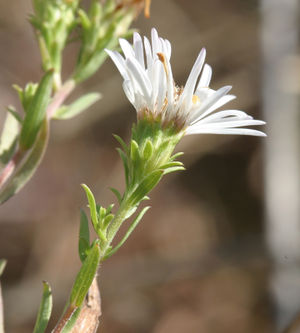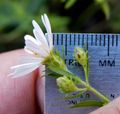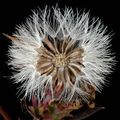Symphyotrichum hallii
- Scientific Name: Symphyotrichum hallii
- Family: Asteraceae
- Common Names: Hall's aster
- Synonyms and misapplications: Aster chilensis, Aster hallii
- Codon: SYMHAL
Contents
Taxonomy
| Trillium albidum ssp. parviflorum | |
|---|---|
| Scientific classification | |
| Kingdom: | Plantae |
| Subkingdom: | Tracheobionta |
| Phylum: | Spermatophyta |
| Subphylum: | Magnoliophyta |
| Class: | Magnoliopsida |
| Subclass: | Asteranae |
| Order: | Asterales |
| Family: | Asteraceae |
| Genus: | Symphyotrichum Nees |
| Species: | Symphyotrichum hallii A. Gray |
Description
Rhizomatous perennial, One to many radiate heads in wide-branching bracteate inflorescences. Inflorescences generally white. Inflorescence bracts generally much smaller than upper stem leaves, involucres 4-7mm high, phyllaries generally bi-colored, papery below and green above, and spreading or slightly recurved to ascending. Lower leaves petiolate and pubescent, upper leaves sessile and usually pubescent.[1][2]
Distinguished from the common Symphyotrichum subspicatum, S. foliaceum, and S. spathulatum by its strongly graduated involucre and outer involucral bracts that are markedly shorter than the inner ones, obtuse and not leaflike. Symphyotrichum ascendens and S. chilense are distinguished by the bracts of their inflorescences, which if present, are mostly erect, greater than 4 times as long as wide, and markedly acute; their rays are usually blue or pinkish (sometimes white).[3]
Bloom Period
July-October
Distribution
Restricted to seasonally wet grasslands and remnant prairies of the Puget Trough of Western Washington and the Willamette Valley, with outlying populations in the Columbia Gorge and Eastern Washington. Threatened in Washington State.[4]
Habitat
Remnant prairie, seasonally wet grasslands.[2]
Photo Gallery
References
- ↑ WTU Herbarium, Burke Museum, & University of Washington. (n.d.). Retrieved from https://biology.burke.washington.edu/herbarium/imagecollection/taxon.php?Taxon=Symphyotrichum%20hallii
- ↑ 2.0 2.1 Hitchcock, C. L., Cronquist, A., Giblin, D., & Legler, B. et al. (2018). Flora of the Pacific Northwest: an illustrated manual. Seattle: University of Washington Press.
- ↑ Rare Plant Field Guide: WA - DNR. Retrieved from https://www.dnr.wa.gov/NHPfieldguide
- ↑ Gilbin, D., Burke Museum, & University of Washington. (n.d.). Symphyotrichum hallii . Retrieved from http://biology.burke.washington.edu/herbarium/waflora/checklist.php?Taxon=Symphyotrichum hallii



